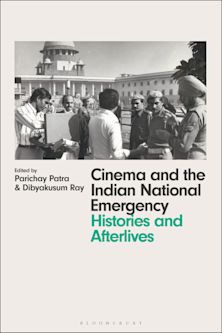- Home
- ACADEMIC
- Asia Studies
- Asian Film and Media
- A Foreigner’s Cinematic Dream of Japan
A Foreigner’s Cinematic Dream of Japan
Representational Politics and Shadows of War in the Japanese-German Coproduction New Earth (1937)
A Foreigner’s Cinematic Dream of Japan
Representational Politics and Shadows of War in the Japanese-German Coproduction New Earth (1937)
You must sign in to add this item to your wishlist. Please sign in or create an account
Description
In early 1936, a German film team arrived in Japan to participate in a film coproduction, intended to show the 'real' Japan to the world and to launch Japanese films into international markets. The two directors, one Japanese and the other German, clashed over the authenticity of the represented Japan and eventually directed two versions, The Samurai's Daughter and New Earth, based on a common script. The resulting films hold a firm place in film history as an exercise in - or reaction against - politically motivated propaganda, respectively.
A Foreigner's Cinematic Dream of Japan contests the resulting oversimplification into nationalised and politicised dichotomies. Drawing on a wide range of Japanese and German original sources, as well as a comparative analysis of the 'German-Japanese version' and the elusive 'Japanese-English version', Iris Haukamp reveals the complexities of this international co-production. This exclusive research sheds light not only on the films themselves, but also on the timeframe of its production, with both countries at the brink of war.
Table of Contents
Acknowledgements
Note on sources and translation
Timeline of related cinematic and political events
Introduction
1. Film export and international (mis-)understanding
2. Producing New Earth: People, stories, inconsistencies
3. A pact of the silver screen
4. The politics of authenticity: Representing others, recognizing selves
5. International stars and national landscapes: Authentic star personas?
6. Itami's version of Fanck's dream
7. Repercussions: Coming to terms with New Earth
Conclusion
Appendices
Filmography
Index
Product details

| Published | 26 Nov 2020 |
|---|---|
| Format | Ebook (Epub & Mobi) |
| Edition | 1st |
| Extent | 272 |
| ISBN | 9781501343544 |
| Imprint | Bloomsbury Academic |
| Illustrations | 75 bw illus |
| Publisher | Bloomsbury Publishing |
About the contributors
Reviews
-
Highly recommended reading for anyone interested in international in co-productions. (A Bloomsbury Translation)
FILMBLATT
-
Two acclaimed directors clash! An international star returns to his native soil! A future national icon debuts! Iris Haukamp captures the moment of such an excitement and retells the complicated behind-the-scene stories of the production of New Earth. What is revealed in this apparently microscopic analysis of one film is a more dynamic ideological and political battle over the authentic image of Japan.
Daisuke Miyao, Professor and the Hajime Mori Chair in Japanese Language and Literature, University of California, San Diego, USA
-
When the word 'scholarship' is used, this is the work to which it should be applied. Iris Haukamp has mined the archives in Japanese, German and English to produce not just the definitive study of a legendary film but brings much-needed attention to one of the most important efforts, fascinatingly failed though it was, in pre-WW II cinema among the Axis Powers. Under the direction of fabled filmmakers Itami Mansaku and Arnold Fanck, this is the film that made Hara Setsuko an abiding star and demonstrates how Japan has long been a foreigner's dream.
David Desser, Emeritus Professor of Cinema Studies, University of Illinois, USA
-
[The] book makes significant contributions to German-Japanese history and film studies.
German Studies Review

ONLINE RESOURCES
Bloomsbury Collections
This book is available on Bloomsbury Collections where your library has access.


































